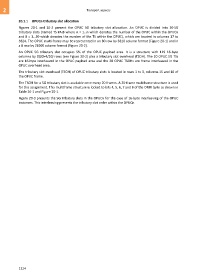Page 1234 - 5G Basics - Core Network Aspects
P. 1234
2 Transport aspects
20.1.1 OPUCn tributary slot allocation
Figures 20-1 and 20-2 present the OPUC 5G tributary slot allocation. An OPUC is divided into 20 5G
tributary slots (named TS #A.B where A = 1…n which denotes the number of the OPUC within the OPUCn
and B = 1…20 which denotes the number of the TS within the OPUC), which are located in columns 17 to
3824. The OPUC multi-frame may be represented in an 80 row by 3810 column format (Figure 20-1) and in
a 8 row by 38100 column format (Figure 20-2).
An OPUC 5G tributary slot occupies 5% of the OPUC payload area. It is a structure with 119 16-byte
columns by 8(20×4/10) rows (see Figure 20-2) plus a tributary slot overhead (TSOH). The 20 OPUC 5G TSs
are 16-byte interleaved in the OPUC payload area and the 20 OPUC TSOHs are frame interleaved in the
OPUC overhead area.
The tributary slot overhead (TSOH) of OPUC tributary slots is located in rows 1 to 3, columns 15 and 16 of
the OPUC frame.
The TSOH for a 5G tributary slot is available once every 20 frames. A 20-frame multiframe structure is used
for this assignment. This multiframe structure is locked to bits 4, 5, 6, 7 and 8 of the OMFI byte as shown in
Table 20-1 and Figure 20-1.
Figure 20-3 presents the 5G tributary slots in the OPUCn for the case of 16-byte interleaving of the OPUC
instances. This interleaving presents the tributary slot order within the OPUCn.
1224

